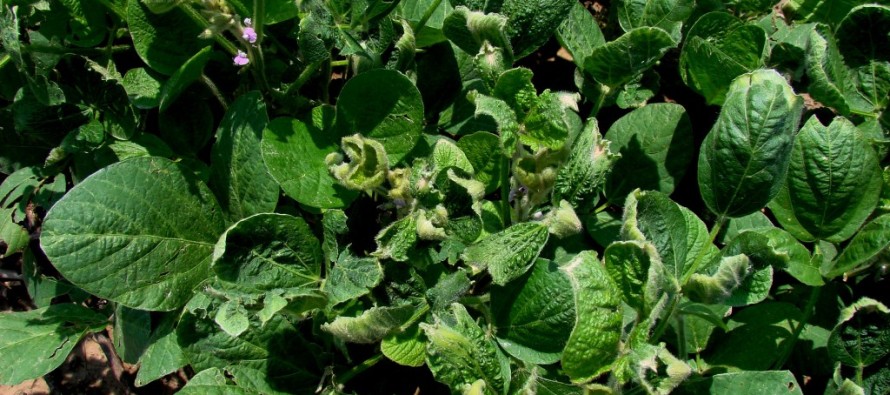Auxin Herbicide Plantback Restrictions

This year has started off much like 2013 and 2014 with several weeks of cold, wet weather in Mississippi. Until this week, essentially no burndown herbicide applications have been made since early- to mid-February. Particularly with corn, growers are ready to plant, but the field requires a burndown. This necessitates discussion on plantback restrictions for 2,4-D and dicamba prior to planting corn and soybean.
Labels for different formulations of dicamba (Clarity, Banvel, etc.) are fairly consistent on plantback restrictions. Dicamba may be applied to fields that will be planted to corn at any time until planting. Once corn is planted, dicamba applications should be avoided until after corn emergence. In fields that will be planted to soybean, the dicamba plantback restriction is strict. The Clarity label states, “following application of Clarity and a minimum accumulation of one inch of rainfall or overhead irrigation, a waiting interval of 14 days is required for 8 fluid ounces per acre, and 28 days is required for 16 ounces per acre. These intervals must be observed or crop injury will occur.” The key point is the rainfall total is required before the clock begins between dicamba application and soybean planting. Cotton may be planted 21 days after dicamba, and grain sorghum and rice may be planted 15 days following dicamba.
The 2015 Weed Control Guidelines for Mississippi (MSU-ES Publication 1532) lists 56 formulations of 2,4-D that are labeled for application in the state. Many of these are only labeled for application to turf, ornamentals, forages, etc. However, there are a multitude of 2,4-D formulations labeled for application to agricultural fields. Agricultural 2,4-D products can be formulated as acid, amine, or ester formulations.
Even though all 2,4-D labels do not contain the same wording, there is continuity concerning plantback restrictions among the labels for 2,4-D products commonly sold this time of year by the distributors in Mississippi. The plantback restrictions in Table 1 are for ester formulations of 2,4-D.
| Table 1. Plantback restrictions for 2,4-D ester formulations applied in burndown applications. | |||||||
| Herbicide | Distributor | Rate | Corn | Cotton1 | Grain sorghum | Rice | Soybean |
| lb ae/A | ___________________ days before planting ___________________ | ||||||
| Barrage HF | Helena Chemical Company | 0.5 | 7 | 30 | 29 | 30 | 7 |
| 1.0 | 14 | 30 | 29 | 30 | 15 | ||
| Havoc LV-Six | Jimmy Sanders | 0.5 | 7 | 30 | 29 | 30 | 7 |
| 1.0 | 14 | 30 | 29 | 30 | 15 | ||
| Salvo | Crop Production Services | 0.5 | 7 | 30 | 29 | 30 | 7 |
| 1.0 | 14 | 30 | 29 | 30 | 15 | ||
| Shredder LV4 | Green Point AG | 0.5 | 7 | 30 | 29 | 30 | 7 |
| 1.0 | 14 | 30 | 29 | 30 | 15 | ||
| 1 The rotational crop restriction for cotton following an application of 2,4-D is incorrect in the 2015 Weed Control Guidelines for Mississippi (MSU-ES Publication 1532). The restriction should be 30 days rather than 3 months as listed in the Weed Control Guidelines. | |||||||
As a general rule, 2,4-D ester is more effective for control of some winter annual weed species including curly dock. Furthermore, ester formulations should be applied when day-time temperatures are <55 to 60 F. When day-time temperatures are consistently >55 to 60 F, then amine formulations should be utilized. If an ester formulation is utilized, the plantback restriction for soybean is 7 days following 2,4-D ester at 0.5 lb ae/A and 15 days following 2,4-D ester at 1.0 lb ae/A. If an amine formulation is utilized, the plantback restriction for soybean planting is 15 days following 2,4-D amine at 0.5 lb ae/A and 30 days following 2,4-D amine at 1.0 lb ae/A. Therefore, caution should be exercised when matching a 2,4-D formulation to the cropping scenario.
2,4-D labels can be frustrating to decipher. Use caution when making applications of auxin herbicides. Better to be safe and read the label of the product that is actually going into the sprayer than to be sorry and suffer consequences from herbicide drift or carryover. Keep in mind that any burndown application of glyphosate plus 2,4-D and/or dicamba will work slowly, even with the warmer weather. If burndown has been delayed and the field is ready to plant, consider changing the burndown to a paraquat-based application.





Let me tell You a sad story ! There are no comments yet, but You can be first one to comment this article.
Write a comment